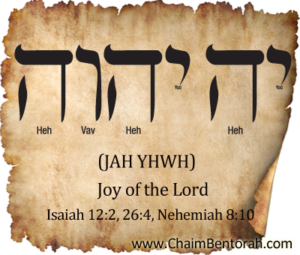Hebrew Word Study – Joy of the Lord – Jah YHWH יה יהוה Yod Hei Yod Hei Vav Hei
Isaiah 12:2: “Behold, God is my salvation; I will trust, and not be afraid: for the LORD JEHOVAH is my strength and my song; he also is become my salvation.”
Isaiah 26:4: “Trust ye in the LORD forever: for in the LORD JEHOVAH is everlasting strength:”
Nehemiah 8:10: “…for the joy of the LORD is your strength.”
 There is something very unusual in these two verses from Isaiah that you would only see in the Hebrew. Only a handful of modern English translations point this out and leave it up to the reader to figure out why this particular Divine Name of God is used. Most translations simply say: “The Lord Jehovah is my strength.” But doesn’t Nehemiah say it is the joy of the Lord which is our strength? I know what you are thinking; “Why do you cut hairs.”
There is something very unusual in these two verses from Isaiah that you would only see in the Hebrew. Only a handful of modern English translations point this out and leave it up to the reader to figure out why this particular Divine Name of God is used. Most translations simply say: “The Lord Jehovah is my strength.” But doesn’t Nehemiah say it is the joy of the Lord which is our strength? I know what you are thinking; “Why do you cut hairs.”
There are only two places in the Hebrew Bible where this form of God’s name is used. It is in Isaiah 12:2 and Isaiah 26:4. In Hebrew, in these verses, the Divine Name used is Yah YHWH. Most commentators ignore to answer the obvious question as to why the abbreviated name of YHWH is used in conjunction with His full name. Those that do address the question seem to write it off with the standard response that when a word is repeated in the Hebrew it is to show emphasis. That is, however, not always the case. Especially when dealing with the Divine Name of God. Why would the God of the Universe, Creator of all things need to have his name emphasized? His name, His unique name alone stands out above all things. No emphasis is needed.
There has to be another reason and some commentators give another reason. That it is s scribal error or something a scribe stuck in there. As proof, they say that the Septuagint does not use the Yah. Well, of course not, because you cannot express this Divine name in the Greek or English for that matter. You can only understand it from the holistic nature of the Hebrew language. If we have to admit to a scribal error then what does that admission do to our understanding of the Scriptures as the inspired word of God?
Would you like Chaim Bentorah as your personal Hebrew teacher?
|
|
In the second temple when you walk through the Court of Women you would come upon a semicircular staircase leading up to the Nicanor Gate which many Bible scholars believe is the Gate called Beautiful as recorded in Acts. This Gate led to the inner court of the temple. The staircase had fifteen stairs. You may recall that Psalms 120-134 are called the Psalms of ascent. One would quote each of these fifteen Psalms as they climbed the fifteen stairs to the Nicanor Gate leading into the realm of God or the inner court where the sacrifices were presented to God. Hence the Psalms of ascent.
Yet, once a year the choir of Levitical priests would descend on these fifteen stairs to perform the water drawing celebration at the end of the festival of Succot. They would start on the top porch and when they blew the trumpets they would begin to descend the fifteen stairs and walk down the stairs into the Woman’s Court. However, they would pause on the tenth step and again blow their trumpets. The Jewish sages teach that the fifteen stairs and the fifteen songs of ascent correspond to the name of God. They say this because the abbreviated name of God is Yah or Yod Hei. The Yod is numerically equivalent to the number 10. That is why they stop on the tenth step to blow the trumpets because the tenth step represents the first letter of God’s name, the Yod which means a message from God is descending. They blow the trumpets to indicate that this message has been sent, that their sins have been forgiven. Then the continue down the remaining five steps which represent the Hei which is the presence of God that comes with the forgiveness of sins and brings great joy. There is much rejoicing, celebrating, and dancing on the women’s court as they continue to the lower levels of the temple mount to collect water from the aqueducts. All this time the rejoicing and celebrating continues.
Throughout the year as a sacrifice is made there is a wine libation that is wine is poured over the sacrifice as an offering to God. Wine is a symbol of blood as Jesus declared in the last supper Matthew 26:27: “And he took the cup (of wine), and gave thanks, and gave [it] to them, saying, Drink ye all of it; (28) For this is my blood of the new testament, which is shed for many for the remission of sins.” However, on the occasion of the Sukkot wine was not poured over the sacrifice but water, the symbol of life and you. This was to declare that their sins were now totally forgiven. Prior to Sukkot, they celebrated Rosh Hashanah where they spent seven days in repentance leading to Yom Kippur where the High Priest offered a sacrifice for the sin of the nation. Then there were four days of refection to consider sins not yet repented for or to consider that while in the flesh they will continue to sin and will need to be continually cleansed of these sins. However, after four days they enter the joyous celebration of Sukkot where they rejoice in the continual forgiveness and cleansing of sin from God.
That is why the Water Drawing Celebration at the end of Sukkot is such a joyous occasion. In fact, the Talmud in Sukkot 51a teaches: “Those who have not seen the joy of the Water Drawing Festivities (held in the Holy Temple in Jerusalem during the festival of Sukkot) has not seen joy in their lives.” Why is this considered the ultimate joy? Because the pouring of water over the sacrifice rather than wine indicates that all sins past, present, and future have been forgiven in God’s realm. In God’s realm where there is no past, present, or future, in fact, time does not exist in God’s realm. Thus, the sacrifice of the Messiah had already been made and their sins were now forgiven for all eternity. Hence the people continue to celebrate in the Women’s Court for 24 hours, without sleep.
Why the Women’s court and why the fifteen stairs? Note the Levites descend nor ascend. The number 15 is the number of the abbreviated name of God. The abbreviated name of God is used in the natural world for the natural world is a lower state than the realm of God. Yet, they rejoice and celebrate in this natural realm for they can still find the joy of the Lord, their strength even in the abbreviated form. Hence the word Yah represents the joy of the Lord which is our strength as Nehemiah said.
Oh, why do they dance in the Women’s Court? It was believed that women were closer to God than men. They received a special gift from God in a spiritual sense to be more spiritually sensitive because they would bear children and be responsible for raising their children to love God. As this role would take much more time and devotion to God, they were granted a deeper spiritual experience than the men. The men had to spend hours in prayer and Torah study to obtain this depth. Thus, the Women’s Court was the closest they could get to God in the natural realms. So, by descending the fifteen stairs or the stairs of Jah they were creating a paradox of ascending to God while descending into the natural realm.
Hi there! Thank you for reading this Daily Word Study. Can I ask a favor? Share this Daily Word Study with your friends on Facebook and Twitter by clicking one of the icons below.
Thanks & Blessings, it means a lot to me!







In God’s realm no past, present or future… in fact time does not exist in God’s realm. Time is a linear, things in our mundane realm move mostly in one direction. Before our realm was God’s word. Breath making vibration with a certain intent. An amazingly wonderous intent. Intent shown in each of the Hebrew letters. Of course He hears each of our prayers at any one moment because He has slowed down light to move no faster here than constant C, what we call the speed of light. It is as if he blew our universe into existence like bubble from chewing gum with His word. Our intent is so important. Our hearts lie open to Him. Thank you for writing this article, Chaim. Your work helps bring me closer to His heart.
This is particularly close to my heart for many reasons. Thank you for the details you add, I am humbled and grateful for the access to your teachings you have shared, I could have never dreamed I would have access to this much deep knowledge of His Word. If it is possible could you please address Psalm 68:11 and the “great company of women”? I know there is something there pertaining to the Word “women” and have wondered about it for many years.
very interesting to study the word in its original languague
Teacher,
What an enormous blessing your insights bring.
Thank you
Other Hebrew Scholars say that Jehovah is a bad translation,the word is LORD-Adonai,because there’s no J’s in the Hebrew r Greek alphabet.Is this correct?The word is a Latin.
Thank you Chaim for this. This has been on my heart and lightbulbs are going off for me.
Shalom,
Brendalee
I couldn’t have had a better devotional for today! The Joy of the LORD – all my sins are washed away – God’s Presence!!! And this Jah YHVH is my Salvation!!! Thank you for the wonderful lesson!!!
Thank you this was very interesting. I had the joy to experience during a Sukkot in 2019 the
water libation ceremony reenactment. Very much a picture of Messiah. Beautifuland meaningful. It is amazing how walking in The Way is so deep and rich. Hal le lu Yah!
My questions have been answered. I am grateful to God.
Wow!! That’s amazing and heart warming. Thanks for bringing it up for us
Very illuminating! Thank you!
So much packed into this lesson, it’s almost overwhelming. Thank you.